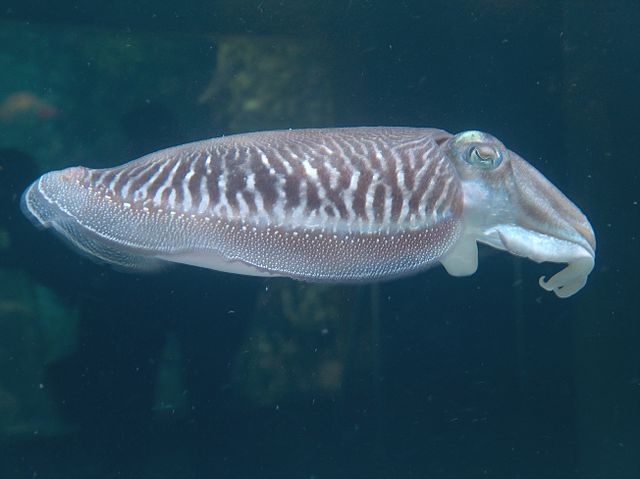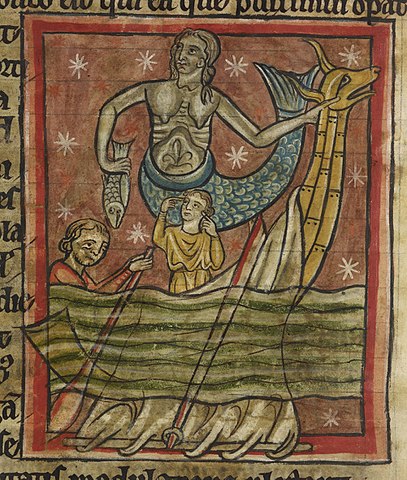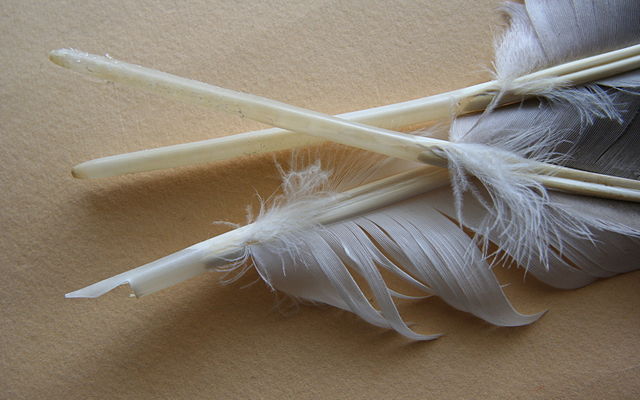Exeter Riddle 74
MEGANCAVELL
Date: Mon 12 Feb 2018Matching Commentaries: Commentary for Exeter Riddle 74
Riddle 74’s translation is by returning guest contributor James Paz, lecturer in early medieval literature at the University of Manchester. Welcome back, James!
Ic wæs fæmne geong, feaxhar cwene,
ond ænlic rinc on ane tid;
fleah mid fuglum ond on flode swom,
deaf under yþe dead mid fiscum,
ond on foldan stop, hæfde ferþ cwicu.
I was a young girl, a grey-haired woman,
and a singular warrior at the same time;
I soared with the birds and swam in the water,
dove under the waves, dead among the fish,
and stepped on land. I held a living spirit.
Notes:
This riddle appears on folio 126v of The Exeter Book.
The above Old English text is based on this edition: Elliott van Kirk Dobbie and George Philip Krapp, eds, The Exeter Book, Anglo-Saxon Poetic Records 3 (New York: Columbia University Press, 1936), page 234.
Note that this edition numbers the text Riddle 72: Craig Williamson, ed., The Old English Riddles of the Exeter Book (Chapel Hill: University of North Carolina Press, 1977), page 109.
Tags: anglo saxon exeter book riddles old english solutions riddle 74 james paz
Related Posts:
Commentary for Exeter Riddles 1-3
Commentary for Exeter Riddle 74
Exeter Riddle 9




Commentary for Exeter Riddle 43
MEGANCAVELL
Date: Mon 17 Aug 2015Matching Riddle: Exeter Riddle 43
Riddle 43’s commentary is once again by the terribly clever James Paz, Lecturer in early medieval English literature at the University of Manchester.
I imagine that solving Riddle 43 would have been fairly easy for most contemporary readers of the Exeter Book, especially if we’re to picture this riddling taking place in a monastic setting. It might not be as immediately obvious for a modern reader today, given the changes to our religious beliefs across time. Even so, literary scholars have arrived at an uncontroversial solution: “soul and body.”
As such, this is a riddle whose solution is not a single word but two, a pairing of some kind (others include “moon and sun” and “cock and hen”). The key to solving this riddle, then, lies in identifying not one wiht (creature/created thing) but two disguised figures: the noble guest and the servant. The closing lines (14b-16) of the riddle point us in this direction, instructing the would-be solver to make known in fitting words (OE cyþe cynewordum) what the guest (cuma) or the servant (esne) is called.
Social and cultural tropes (evocative of Beowulf as well as other heroic and elegiac poems) are referenced but also played with, in order to lead us to the right answer. The riddle asks us to puzzle over the proper relationship between host and guest, the hierarchy of lord and servant, to consider the threat of hunger and disease and old age, the joys of feasting and the mead hall. It also creates confusion over traditional familial roles (why should one brother fear, or be in awe of, the other? how can one woman be both mother and sister?) and privileges honourable conduct while raising the threat of its disruption (what happens when a servant obeys his master evilly?).
A basic explanation of the “soul and body” solution would be as follows. The noble guest is the soul, which, as the riddle explains, is not vulnerable to hunger pangs or burning thirst or even old age. Its servant is the body, whose proper role is to tend to this guest honourably (arlice) before it departs for a journey. Having some knowledge of Old English kennings for “body” such as ban-hus (i.e. bone-house) help us to reach this solution. These compressed metaphors (miniature riddles, if you like) suggest that human bodies are temporary dwellings, sheltering and safeguarding something dear that must nevertheless be on its way again before long.
Photo of the 8th-century whalebone Franks Casket (by Michel wal). Licensed under CC BY-SA 3.0 via Wikimedia Commons.
The woman referred to in lines 13-14 has proved a little trickier to identify, but most critics and translators think that she represents the earth. She is called a mother, because the body of Adam was made from dust (see Genesis 2:7), and a sister because she (the earth) was shaped by the same father, God.
The critic John D. Niles has recently encouraged us to answer the Exeter Book Riddles in their own (Old English, though sometimes Latin) tongue whenever possible. If we’re to do so with Riddle 43, one half of the answer should correspond to the masculine noun hlaford (i.e. “lord”) and the other half to the masculine noun esne (i.e. “servant”). For Niles and, before him, Moritz Trautmann, the spoken solution should be the Old English doublet gæst ond lic-hama.
But speaking the solution is not where this riddle ends; it is, perhaps, where it begins to reveal its meaning. I’ve said that this riddle is “easy” to solve but, actually, its solution encourages us to contemplate “soul and body” as a concept at a far deeper level.
Regular readers of this website might have gained the sense that the Exeter Book Riddles are all about what we’d nowadays call the “nonhuman” world in its various forms: shields, swords, swans, leather, horns, mead, moon and sun, storms and earthquakes. But Riddle 43 examines medieval ideas about what it means to be a human being: embodied yet rational of mind or soul, of this world yet alienated from it, intellectually curious yet driven by carnal desire.
For an early medieval Christian audience, humans are essentially embodied souls. So the owner of a body really ought to be its master. But that servile role is tested throughout these riddles. Recall Riddle 25 (onion?). As we read this riddle (and, tellingly, Riddles 44, 45, 46), genitalia and sex acts shift in and out of focus… and our body responds?
Even the act of reading a non-obscene riddle is not purely intellectual. Riddles are about body parts and they call on body parts: eyes, ears, mouths, even hands. Riddling asks for a reader who’ll engage with the words on the page in a sensuous way. Recurring phrases that run throughout the Exeter Riddles support this claim: ic seah, ic gefrægn, saga hwæt ic hatte (see, hear, say). And so the relationship that Riddle 43 sets up between our “higher” intellectual faculties and our “baser” or more servile bodily functions is particularly appropriate to this enigmatic collection.
Mastery of the body is central to Riddle 43. It’s all about how the body should respond to its hlaforde (lord) and frean (master). The body, described as an esne, must keep his noble guest honourably, serve him, and fear retaliation after death should he disobey the superior soul. Notice how Riddle 43 uses this term, esne, three times in sixteen lines to emphasise the role of the body.
Leslie Lockett has shown that in the Old English laws, esne is a term for a servant of indeterminate status, higher than the slave (ðeow or wealh) but subordinate to the free labourer (ceorl). Therefore, an esne performs a servile role yet has more autonomy than a slave. This is definitely worth remembering when thinking about the relationship between soul and body in Riddle 43.
When I teach Riddle 43 on my “Things that Talk” course at the University of Manchester, it starts to spark deeper discussion when compared with the other Soul and Body poems found in Old English literature. The issue of the soul’s control over the body was obviously very important to early medieval readers, as a longer Soul and Body poem exists in two versions, which is unusual for an OE text. Those two versions appear in the Vercelli Book and in the same Exeter Book that contains the riddles.
What’s interesting here is that the two versions of the Soul and Body poem provide a different take on the master-servant relationship to that portrayed in Riddle 43. In this poem, the damned soul speaks to an offending body which, during their life-journey together, indulged its own desires, worked against the soul, starved it of spiritual sustenance, and imprisoned, even tortured, it. The soul’s apparent helplessness in the Old English Soul and Body poems has surprised some critics, who expect a deeply Christian text to depict a soul endowed with free will and reason, capable of disciplining the body. Yet the soul that emerges from these poems often seems to be an entity incapable of completely independent thought or action, an entity that struggles to bring about the fulfilment of its desires, as long as it’s enclosed in flesh.
The contrasting depictions of a servile body labouring for its noble guest on the one hand, and a damned soul addressing a domineering body, to which it was bound unwillingly, suggest that early medieval poets had complex ways of comprehending the human condition. Of course, these issues remain fascinating (and maybe even disquieting) for us as modern readers of early medieval poetry…
… To what extent are we responsible for our own actions? Who or what is in control of our everyday thoughts, words and deeds during life? Do we know where our dreams and desires come from? Does our body always behave as we want it to? Are our bodies us, or are we our brains, or minds, or do we still believe our true identity to be spiritual in nature? The Exeter Riddles seem to be about speaking objects. Yet where do we locate the speaking and thinking and acting “I” within our own, human selves? In the body? In the mind? Or within that elusive concept of a soul?
That’s the real mystery at the heart of Riddle 43, and, over one thousand years on, we are not much closer to solving it.
References and Suggested Reading
Crossley-Holland, Kevin, trans. The Exeter Book Riddles. London: Enitharmon, 2008.
Dailey, Patricia. “Riddles, Wonder and Responsiveness in Anglo-Saxon Literature.” In The Cambridge History of Early Medieval English Literature. Edited by Clare A. Lees. Cambridge: Cambridge University Press, 2012, pages 451-72.
Lockett, Leslie. Anglo-Saxon Psychologies in the Vernacular and Latin Traditions. Toronto: University of Toronto Press, 2011.
Murphy, Patrick J. Unriddling the Exeter Riddles. University Park, PA: Penn State University Press, 2011.
Niles, John D. Old English Enigmatic Poems and the Play of the Texts. Turnhout: Brepols, 2006.
Williamson, Craig, ed. and trans. A Feast of Creatures: Anglo-Saxon Riddle Songs. Philadelphia: University of Pennsylvania Press, 1982.
Tags: anglo saxon exeter book riddles old english solutions riddle 43 james paz
Related Posts:
Commentary for Exeter Riddle 25
Commentary for Exeter Riddle 45
Commentary for Exeter Riddle 44
Commentary for Exeter Riddle 46